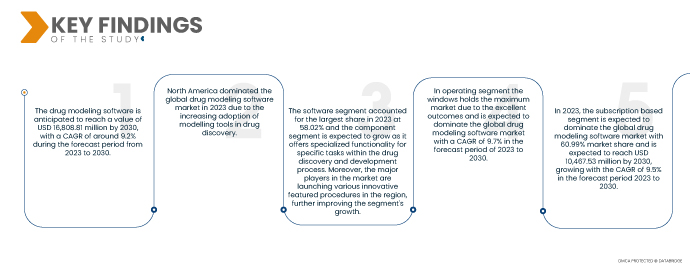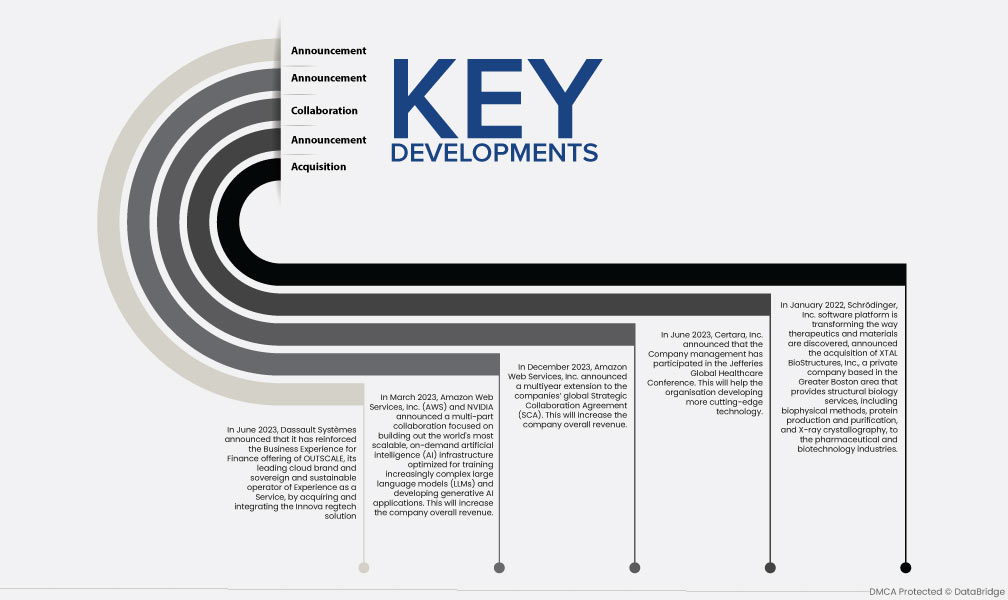Drug modelling software adoption is intimately related to the expanding demand for novel therapeutics in the pharmaceutical sector. Drug modelling software is essential for enhancing drug prospects, speeding up the drug research and development process, and increasing the success rates of novel medicines.
Access Full Report at https://www.databridgemarketresearch.com/reports/global-drug-modeling-software-market
The World Health Organization estimates that chronic diseases account for approximately 71% of all deaths worldwide. The increasing prevalence of these conditions drives the demand for novel therapies that can provide better disease management, improved outcomes, and enhanced quality of life for patients.
Drug modelling software is being used more frequently as a result of its potential to produce targeted therapeutics, accelerate the drug development process, improve drug candidates, facilitate virtual screening, and enhance combination medicines. Therefore, rising demand for novel therapies is expected to drive the market growth.
Data Bridge Market Research analyses that the Drug Modelling Software Market is expected to grow with a CAGR of 9.2% in the forecast period from 2023 to 2030, and is expected to reach USD 16,808.81 million by 2030.
Key Findings of the Study
Cloud Computing and Big Data Analytics in Drug Modelling
Organizations are using cloud computing and big data analytics technology to handle immense volumes of data with better automation, generate data driven insights, mimic human intelligence and much more. The wide range of benefits offered by cloud computing and big data analytics is increasing its adoption in almost every business. Today, many leading pharma companies are leveraging cloud computing and big data analytics technology to enhance their processes of manufacturing, drug research, and development.
Some of the cloud computing and big data analytics aspects that contribute to quickening the drug discovery process are:
- Data analytics capabilities of cloud computing and big data analytics in drug discovery let researchers swiftly navigate through loads of data points that can help gauge the target molecules’ capabilities.
- Cloud computing and big data analytics in drug discovery are expediting the analysis of massive medical data sets, generate data-driven insights, and predict future needs.
- Predictive analytics capabilities of Cloud computing and big data analytics contribute to identifying and develop accurate chemical compositions, speed up trials, and decide which new drug to manufacture.
- Cloud computing and big data analytics are contributing to the manufacturing good quality medicinal products, filtering and employ best-matched patients for clinical trials and enhancing the protection and efficiency of drugs during clinical trials.
Cloud computing and big data analytics have the potential to accelerate drug discovery and development by improving computational capabilities, enhancing collaboration, and enabling advanced data analysis. As these technologies continue to evolve, they are expected to play a significant role in enhancing the efficiency and effectiveness of drug modeling workflows. When handling intricate calculations, simulations, and data analysis, drug modelling frequently necessitates the use of powerful computing resources. Scalable and on-demand access to high-performance computer resources is made possible by cloud computing. To execute computationally demanding activities, researchers can use cloud platforms, which eliminates the need for costly local infrastructure. Workflows for drug modelling are made faster and more effectively because of their scalability.
Large amounts of data, such as molecular structures, outcomes of experiments, and clinical data must be manipulated while modeling drugs. Cloud computing provides safe and affordable storage options, enabling researchers to manage and store enormous amounts of data. Data accessibility, scalability, and strong backup and recovery methods are all guaranteed by cloud-based storage.
In order to simulate drugs, massive and varied datasets can be mined using big data analytics approaches. Researchers can use modern analytics algorithms, such machine learning and data mining, to analyse and interpret complicated drug-related data by utilizing cloud computing capabilities. These methods enable target identification, lead optimization, and drug repurposing by spotting patterns, correlations, and trends.
Therefore cloud computing and big data analytics in drug modelling are expected to create an opportunity for the growth of the market.
Report Scope and Market Segmentation
|
Report Metric
|
Details
|
|
Forecast Period
|
2023 to 2030
|
|
Base Year
|
2022
|
|
Historic Year
|
2021 (Customizable to 2015 - 2020)
|
|
Quantitative Units
|
Revenue in Million, Pricing in USD
|
|
Segments Covered
|
Components (Software, and Services), Operating System (Windows, Linux, Mac Os, and Others), Deployment Mode (Cloud Based, Hybrid-Based, and On-Premises), Enterprise Size (Large Enterprise Size, Small & Medium Enterprise Size), Application (Graphical Molecular Modeling, Gene Sequence Analysis, Protein Modeling, Modeling Crystal Structures, Cheminformatics, High Throughput Virtual Screening, Gas & Solution Phase Reaction, Medical Imaging, and Others), Purchase Model (Subscription Based, and One- Time License), End User (Pharmaceutical & Biotechnology Companies, Contract Research Organization, Research Institutes, Regulatory Authorities, and Others)
|
|
Countries Covered
|
U.S., Canada, and Mexico, Germany, France, U.K., Italy, Russia, Spain, Turkey, Netherlands, Switzerland, Belgium, Poland, Sweden, Denmark, Finland, Norway, and Rest of Europe, China, Japan, South Korea, India, Australia, Singapore, Thailand, Indonesia, Philippines, Malaysia, New Zealand, Vietnam, Taiwan, and Rest of Asia-Pacific, Brazil, Argentina, and Rest of South America, South Africa, Saudi Arabia, U.A.E., Egypt, Israel, Oman, Bahrain, Kuwait, Qatar, and Rest of Middle East and Africa
|
|
Market Players Covered
|
Dassault Systèmes (France), Amazon Web Services, Inc. (U.S.), Certara, USA (U.S.)., Schrödinger, Inc. (U.S.), Cresset. (U.K.), SIMULATIONS PLUS. (U.S.), XtalPi Inc. (China), Dotmatics (U.S.), Scripps Research (U.S.), Xybion (New Jersey), BioSolveIT GmbH. (Germany), ArgusLab (U.S.), Pharmacelera (Spain), Optibrium, Ltd. (U.K.), Nanome Inc. (U.S.), BC Platforms (Switzerland), Atomwise Inc. (U.S.), VeriSIM Life. (U.S.), Acellera LTD. (U.K.), GENECODE (Estonia), InSilicoTrials Technologies. (U.S.) among others.
|
|
Data Points Covered in the Report
|
In addition to the insights on market scenarios such as market value, growth rate, segmentation, geographical coverage, and major players, the market reports curated by the Data Bridge Market Research also include depth expert analysis, patient epidemiology, pipeline analysis, pricing analysis, and regulatory framework.
|
Segment Analysis:
The global drug modeling software market is segmented into seven notable segment namely, components, operating system, deployment mode, enterprise size, application, purchasing model, end user.
- Based on components, global drug modelling software market is segmented into software and services. In 2023, the software segment is expected to dominate the drug modelling software market with 58.02% market share.
In 2023, the software segment is expected to dominate the global drug modeling software market
In 2023, the software segment is expected to dominate the global drug modeling software market as it offers comprehensive solutions that encompass a wide range of functionalities required in the drug discovery and development process.
- Based on operating system, global drug modeling software market is segmented into windows, linux, mac os, and others. In 2023, the windows segment is expected to dominate the drug modeling software market with 64.64% market share.
In 2023, the windows segment is expected to dominate the global drug modeling software market
In 2023, the windows segment is expected to dominate the global drug modeling software market as it is easily available with a broad range of options.
- Based on deployment mode, global drug modeling software market is segmented into cloud based, hybrid-based, and on-premises. In 2023, the cloud based segment is expected to dominate the drug modeling software market with 58.79% market share.
- Based on enterprise size, global drug modeling software market is segmented into large enterprise size and small & medium enterprise size. In 2023, the large enterprise size segment is expected to dominate the drug modeling software market with 66.70% market share.
- Based on the application, global drug modeling software market is segmented into graphical molecular modeling, gene sequence analysis, protein modeling, modeling crystal structures, cheminformatics, high throughput virtual screening, gas & solution phase reaction, medical imaging, and others. In 2023, the graphical molecular modeling segment is expected to dominate the drug modeling software market with 30.99% market share.
- Based on the purchasing model, global drug modeling software market is segmented into subscription based, and one- time license. In 2023, the subscription based segment is expected to dominate the drug modeling software market with 60.99% market share.
- Based on end user, global drug modeling software market is segmented into pharmaceutical & biotechnology companies, contract research organization, research institutes, regulatory authorities, and others. In 2023, the pharmaceutical & biotechnology companies segment is expected to dominate the drug modeling software market with 50.88% market share.
Major Players
Data Bridge Market Research recognizes the following companies as the market players in global drug modeling software market are Dassault Systèmes (France), Amazon Web Services, Inc. (U.S.), Certara, USA (U.S.)., Schrödinger, Inc. (U.S.), Cresset. (U.K.), SIMULATIONS PLUS. (U.S.), XtalPi Inc. (China), Dotmatics (U.S.), Scripps Research (U.S.), Xybion (New Jersey), BioSolveIT GmbH. (Germany), ArgusLab (U.S.), Pharmacelera (Spain), Optibrium, Ltd. (U.K.), Nanome Inc. (U.S.), BC Platforms (Switzerland), Atomwise Inc. (U.S.), VeriSIM Life. (U.S.), Acellera LTD. (U.K.), GENECODE (Estonia), InSilicoTrials Technologies. (U.S.) among others.
Market Development
- In June 2023, Dassault Systèmes announced that it has reinforced the Business Experience for Finance offering of OUTSCALE, its leading cloud brand and sovereign and sustainable operator of Experience as a Service, by acquiring and integrating the Innova regtech solution.
- In March 2023, Amazon Web Services, Inc. (AWS) and NVIDIA announced a multi-part collaboration focused on building out the world's most scalable, on-demand artificial intelligence (AI) infrastructure optimized for training increasingly complex large language models (LLMs) and developing generative AI applications. This will increase the company overall revenue.
- In December 2023, Amazon Web Services, Inc. announced a multiyear extension to the companies’ global Strategic Collaboration Agreement (SCA). This will increase the company overall revenue.
- In June 2023, Certara, Inc. announced that the Company management has participated in the Jefferies Global Healthcare Conference. This will help the organisation developing more cutting-edge technology.
- In January 2022, Schrödinger, Inc. software platform is transforming the way therapeutics and materials are discovered, announced the acquisition of XTAL BioStructures, Inc., a private company based in the Greater Boston area that provides structural biology services, including biophysical methods, protein production and purification, and X-ray crystallography, to the pharmaceutical and biotechnology industries.
Regional Analysis
Geographically, the countries covered in the global drug modeling software market report are U.S., Canada, and Mexico, Germany, France, U.K., Italy, Russia, Spain, Turkey, Netherlands, Switzerland, Belgium, Poland, Sweden, Denmark, Finland, Norway, and Rest of Europe, China, Japan, South Korea, India, Australia, Singapore, Thailand, Indonesia, Philippines, Malaysia, New Zealand, Vietnam, Taiwan, and Rest of Asia-Pacific, Brazil, Argentina, and Rest of South America, South Africa, Saudi Arabia, U.A.E., Egypt, Israel, Oman, Bahrain, Kuwait, Qatar, and Rest of Middle East and Africa as per Data Bridge Market Research analysis:
North America is the dominant and fastest growing region in global drug modeling software market during the forecast period 2023 -2030.
In 2023, North America dominated the drug modeling software market owing to the higher level of investments by various manufacturers and increasing technological advancements in the region. North America will continue to dominate the drug modeling software market in terms of market share and market revenue and will continue to flourish its dominance during the forecast period. Also, North America is estimated to be the fastest growing region in drug modeling software market the forecast period 2023 -2030, due to the growing adoption of advanced technology and launch of new products in this region.
For more detailed information about the drug modeling software market report, click here – https://www.databridgemarketresearch.com/reports/global-drug-modeling-software-market












